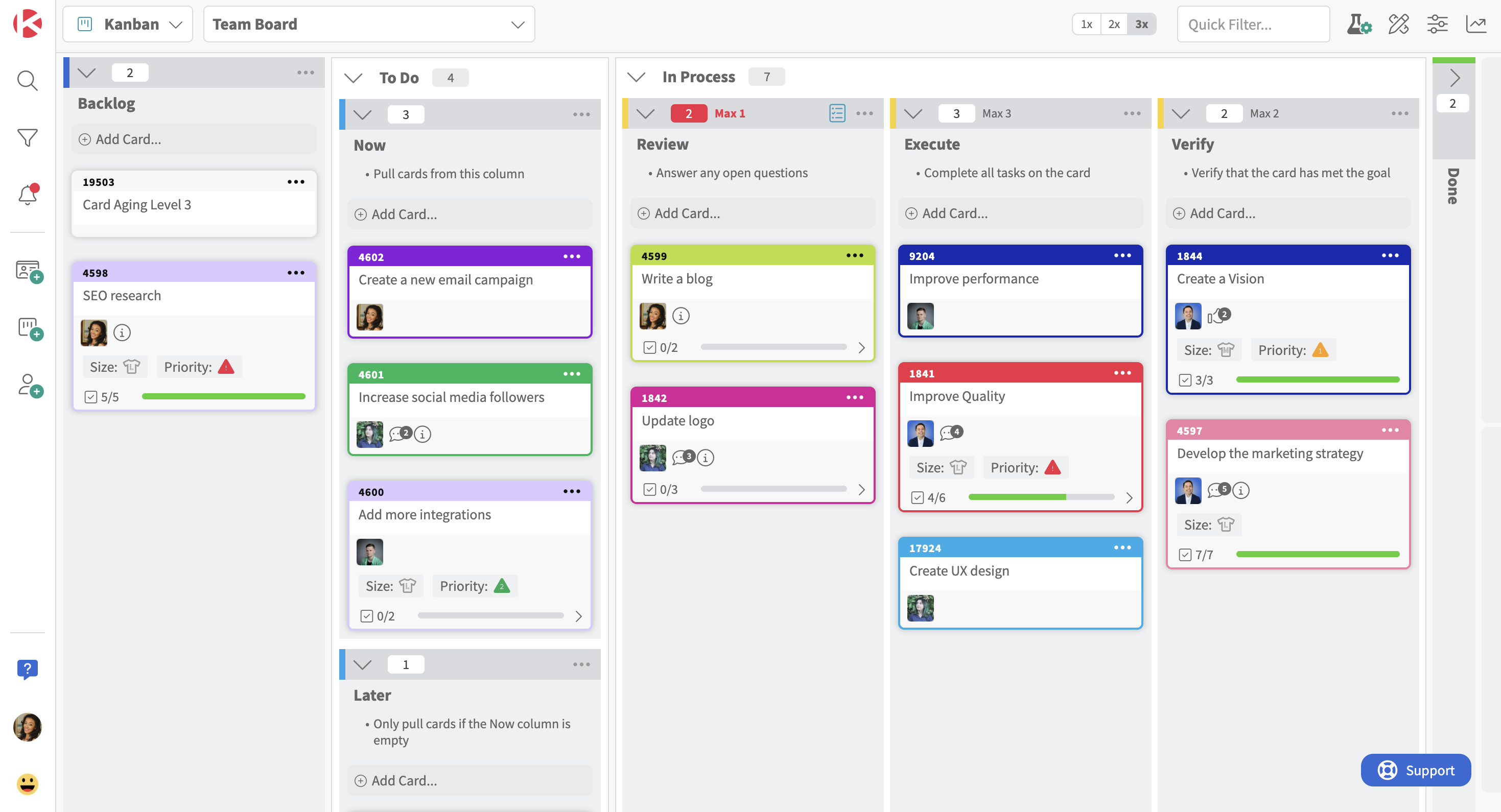
Today’s business landscape moves fast, and it demands you keep pace.
Evolving technology, rapidly moving market trends, and increased consumer demands force businesses to acclimate over and over again to change. Traditional operations are holding us back as they often rely on top-down decision-making that can slow down innovation and experimentation.
Businesses need a new method that prioritizes delivering value and thrives on continuous progress – something like Agile.
If you’re considering implementing Agile into your business operations, this article will help you:
- Learn more about Agile operations
- Understand the core principles of Agile and the benefits it can bring to your business
- Implement Agile operations in your business
So, let’s talk about all things Agile.
What is Agile Operations?
Once a software project management methodology, Agile has emerged as a solution to a variety of business problems.
Traditionally, businesses operated from A to B to C – a decision was made, steps were planned and implemented, and a whole solution was presented at the end. The roadmap was plotted from start to finish with no diversions.
But we no longer live in that world.
AgileOps takes the principles of software development to create a flexible, value-driven, customer-centric methodology that helps businesses move fast with a go-to-market strategy.
Agile breaks larger projects down into smaller iterations, with faster delivery times and continuous assessment and improvement. The roadmap isn’t set; teams are encouraged to innovate, brainstorm, and switch things up.
In this way, AgileOps lets businesses pivot mid-project, reacting quickly to market changes and feedback.
Benefits of Implementing Agile in Operations
Before you jump into AgileOps, let’s look at the benefits it can bring to your organization.
Enhances team collaboration and fosters better teamwork
Teamwork is the backbone of AgileOps.
Agile operations takes away the traditional hierarchy of project management. Agile teams value every voice, with each team member taking ownership of the project and its outcomes.
With speed and value at the forefront, teams are encouraged to speak up, innovate, brainstorm, and engage.
The very nature of Agile is about quick, tangible results based on continuous feedback and assessment. Teams are encouraged to communicate and collaborate to achieve this continuous cycle, and that mindset only deepens as your Agile operations mature.
Improves project visibility and transparency to ensure better oversight
Adopting Agile means eliminating a top-down, need-to-know approach to project management. Everyone is a stakeholder, and transparency is key.
Progress, tasks, feedback, roadblocks, and even failures are visible to every team member.
Project transparency is valuable for demonstrating value to leadership, turning teams into stakeholders, and monitoring progress. This can be particularly effective with Portfolio Kanban, as you can connect workflows across your organization to create transparency and ensure all your projects and tasks are strategically aligned to your goals.

Accelerates delivery times and enables quicker project completion
Agile operations is all about breaking bigger projects down into smaller iterations. These “sprints” allow teams to work on bigger parts of the whole for shorter periods of time.
As parts of larger operations are delivered, they can be assessed and improved if needed. This increases the chances of the final project being problem-free.
Boosts customer satisfaction and strengthens client relationships
Agile software development allows software developers to release early, gather end-user feedback, add requested features, fix bugs, and continuously improve.
Agile operations work the same way, whether the project is a new product or a marketing campaign. AgileOps relies on customer feedback in early stages to continuously improve.
This kind of customer engagement builds trust, as customers feel heard and even involved in your operations. It turns customers into stakeholders, building stronger and more lasting relationships.
Encourages continuous improvement and ongoing development
The “create, assess, improve” cycle of AgileOps means operations are never static. Your business is never locked into a rigid path – you’re always primed to move with feedback, market trends, and new data.
If a new customer trend emerges, you can quickly pivot to capitalize on it.
Steps to Implement Agile Operations in Your Business
Implementing Agile means turning away from traditional methods and embracing a new mindset.
Define objectives for clear goals and expectations
Agile goals skew the traditional SMART (specific, measurable, actionable, relevant, time-bound) format for a more flexible process.
Agile goals should focus on the following:
- Delivering value quickly
- Representing the vision of your business
- Targeting multiple things with shorter time-frames
For example, suppose your goal is to create a business contact database. In that case, your team should understand the problem (slow sales prospecting), the solution (creating a comprehensive, filterable database), and realistic timeframes for delivery (how long each iteration will take).
The parts in between are a flexible process, not a rigid checklist of immovable targets. Roadblocks, new ideas, and feedback-based changes are all integral to AgileOps.
Educate teams on Agile principles to improve their proficiency
That brings us to our next point: ensuring teams understand Agile principles.
Team members should understand that Agile thrives on those roadblocks, encourages the spark of new ideas, and demands feedback at every stage.
Teams switching to Agile might become discouraged by the lack of a rigid approach. Agile training can help smooth this transition.
Develop a structured Agile framework for organized implementation
There are a few Agile frameworks you can utilize.
Scrum
Projects are divided into smaller sprints, each sprint ending with a deliverable piece of the whole. Scrum is great for large projects where pivots are expected along the way.
Kanban
Kanban allows teams to visualize progress through a Kanban board, where jobs are placed in columns representing completeness – to-do, in progress, complete.
Using Kanban also helps limit the amount of work-in-progress items across each step, reducing project cycle time and helps teams to focus on what’s at hand before starting a new task.

Try Kanban Zone for 30 days and find out how it can help improve your Agile team’s productivity.
Lean
Like its name suggests, lean cuts out anything that doesn’t add to the project and helps teams focus on bringing value to the end user.
The beauty of AgileOps is that you can take features from these frameworks and create something that works for your unique team.
Implement Agile tools and practices for effective execution
Agile practices focus on collaboration, flexibility, visualization, and quick turnaround.
You’ll need some tools to help.
For team communications, apps like Slack can improve collaboration. For timeline and workflow help, platforms like Kanban Zone can help teams track projects and easily visualize progress. As an added benefit, you can collect workflow performance data and identify data-driven opportunities for process improvement.
Monitor and evaluate progress for continuous improvement
AgileOps thrives on continuous feedback and evaluation. To ensure continuous improvement, you should:
- Schedule regular meetings and reviews with teams. One example of this is a daily standup – a quick review at the end of each day to discuss problems, ideas, and progress
- Gather feedback from end-users
- Track delivery times
- Constantly assess operations for weaknesses and implement improvements
Make sure you keep your AgileOps teams innovative and your operations sharp.
Conclusion
Agile operations involves doing away with traditional methods to keep pace with fast-moving markets and emerging technology.
AgileOps can transform your business. Stop being a step behind and become a pioneer in new trends, innovative tech, and consumer satisfaction by implementing Agile operations into your organization.
But, don’t stop there. Use Kanban boards to make sure that your Agile team is collaborative, productive, and set up for success!
This was a guest blog. Please review our guest blog disclaimer.
Learn to Work Smarter, Not Harder!
Get our top articles weekly.
Table Of Contents
Discover many more posts…







